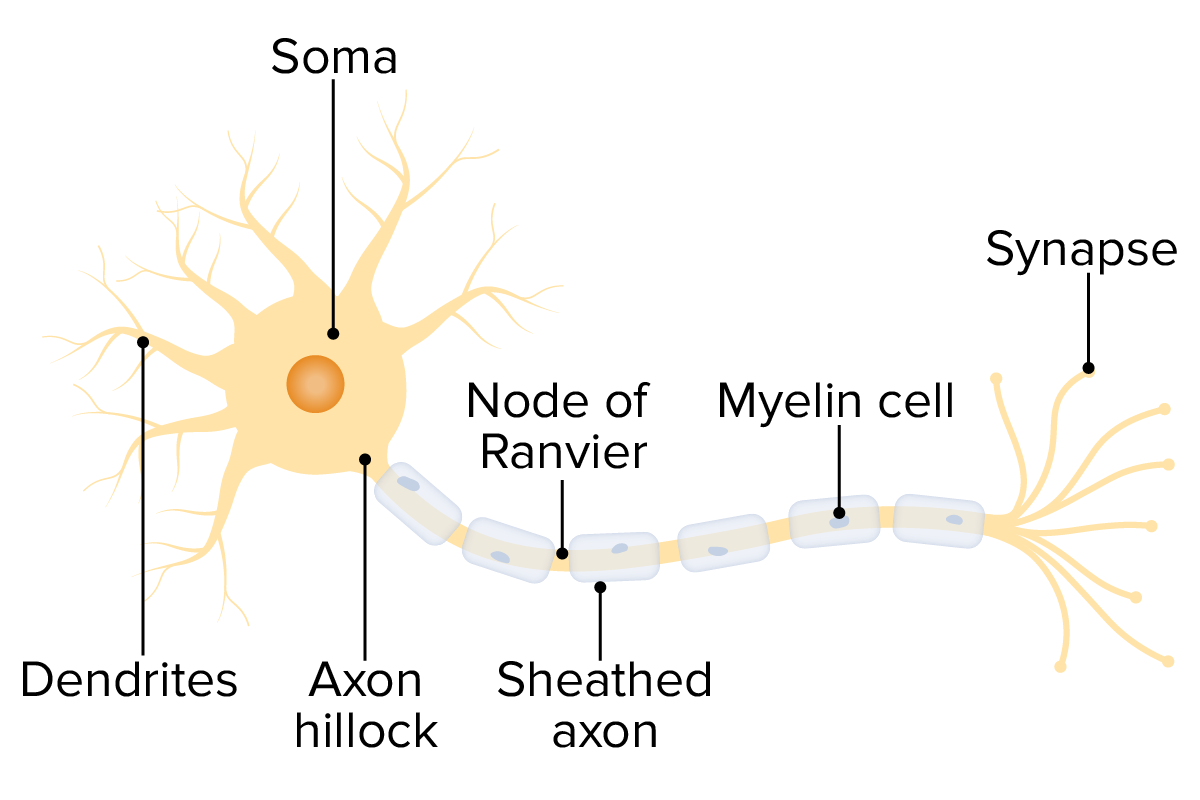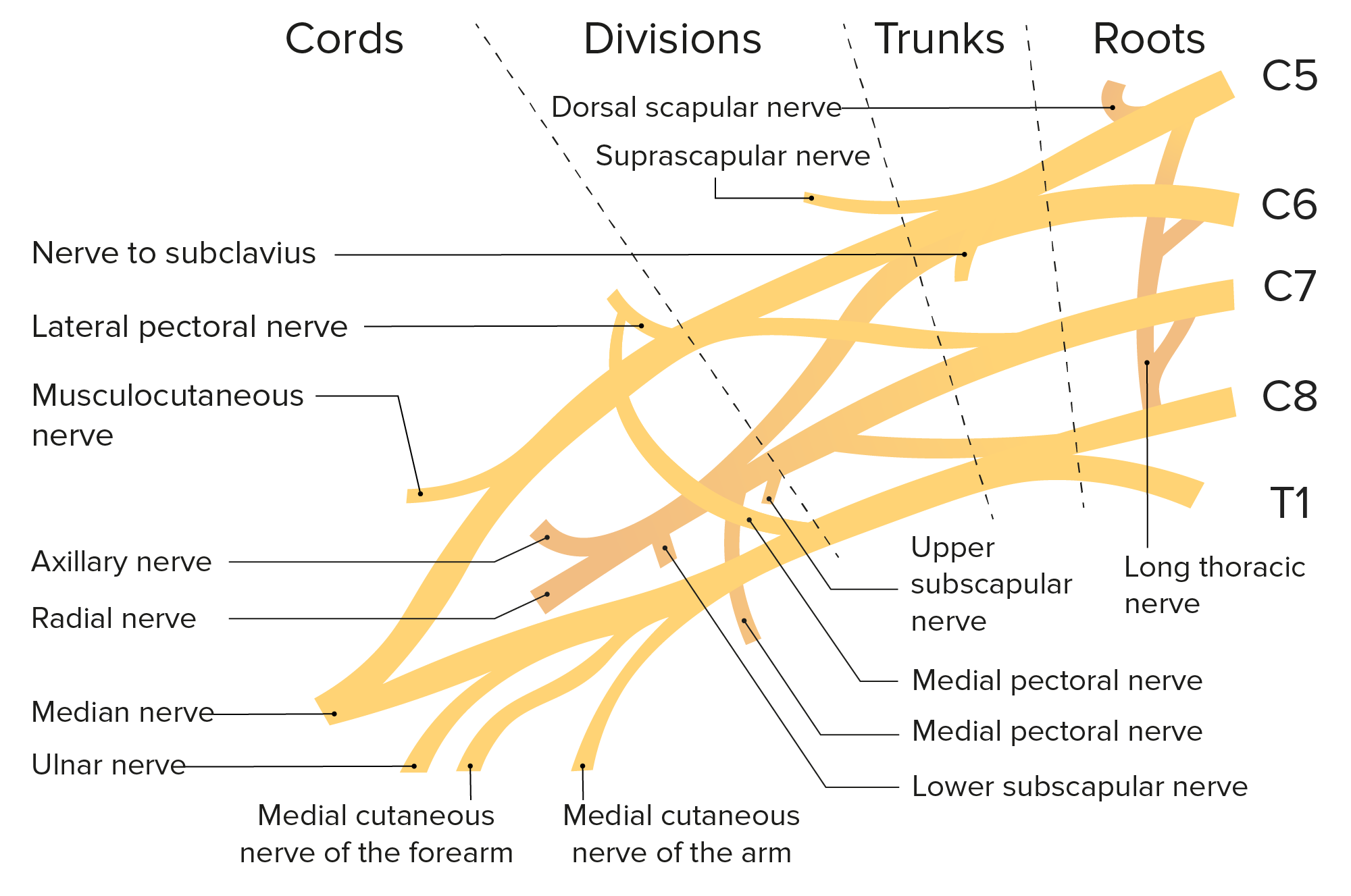Playlist
Show Playlist
Hide Playlist
Entrapment, Compressive and Peripheral Neuropathy
-
Slides 07 PolyneuropathyIndusIntellect Neuropathology.pdf
-
Reference List Pathology.pdf
-
Download Lecture Overview
00:01 Entrapment or compression type of neuropathy. 00:04 Here, let’s say that remember way back when we did median nerve, and we did, and we did in great detail. 00:11 And with the median nerve, down by the wrist will be the most common location, and what you’re seeing here is exactly that. 00:18 And here, you have your carpal tunnel, and let’s say that you have a patient that works with the hands a lot, maybe gaming, joystick, whatever. 00:27 And so therefore, they may then cause inflammation of this region and therefore cause compression of or entrapment of your nerves. 00:36 Ulnar nerve at the elbow, radial nerve in the spiral groove, peroneal nerve at the fibular head, and lateral cutaneous nerve of the thigh, all extremely important. 00:48 And remember, when we talked about the femoral nerve in great detail, we talked about something called meralgia paresthetica. 00:54 These are entrapment issues, and very, very -- well, let me say very, very common but could be a common presentation based on the occupation and habits of your patients. 01:06 Under peripheral neuropathy. 01:08 Acute, generally, here you go. 01:10 There is a list of AIDP, porphyrias, diphtheria, polio, toxins, your acute type of issues. 01:17 Subacute: deficiency states, maybe toxins, uremia, diabetes, sarcoidosis, paraneoplastic, just keep things in perspective. 01:27 Your chronic with CIDP, chronic inflammatory demyelinating polyneuropathy, diabetes, maybe once again, renal failure. 01:35 And then finally, we have relapsing, more or less kind of behaves like your multiple sclerosis but this would be chronic. 01:44 Where are we? In the periphery, right? So peripheral neuropathy. 01:48 And we know that multiple sclerosis only affects the central, all right? It's simple. 01:53 The things that you want to be very clear about organization. 01:56 Our topic for quite some time now has been peripheral neuropathy, and really, what we’re going to do as we move forward here just to make sure we summarize and organize our thoughts, is make sure that you know how to approach or have a proper clinical approach to such neuropathies. 02:15 This is actually quite beautiful. 02:18 I say actually as if I’m in disbelief, but every time I see this -- you should get excited. 02:25 Every time I see this, I don’t care if I’ve been seeing this for 5, 10, 15, 20 years. 02:32 Every single day, every single time I see it, I get excited. 02:34 Why? Because really, it does organize your demyelinating or neuropathies in great detail. 02:41 So let’s set this up for you. 02:43 If you take a look at the middle there, the target in the middle, okay? That’s your acute. 02:47 And then around your acute, you have your various diseases. 02:50 And then if you go outside this ring of acute, then you start getting into your subacute, which means it takes a little bit longer. 02:57 And then outside of your subacute, you start getting into your chronic type of demyelinating diseases. 03:02 As you move from your left and then to your right, you’ll notice that you have demyelinating diseases. 03:08 And then as you move into the right, then you have less of a demyelinating and it’s more of an axonal. 03:13 For example, CMT-2. 03:15 What does CMT stand for? Charcot-Marie-Tooth type of issues. 03:20 And then if you go from top to bottom, you’ll have what’s known as symmetrical type of issues, versus asymmetrical. 03:26 For example, with diabetes, or even when you see the first green box there, and that is chronic renal failure. 03:33 And there is uremic neuropathy, and the reason we say that is because if your kidneys fail, my goodness gracious, you’re going to start accumulating all kinds of toxins, and some of those toxins can be extremely damaging to the nerves. 03:48 And then as you move from top to bottom, you’re moving into your asymmetrical type of issues. 03:55 If I were you, once you’ve truly understood your peripheral neuropathies and such, you want to walk through here and give yourself a really good organization pattern Perhaps, even close your eyes or take a different piece of paper and write down on your own, every step of the way, all these different diseases, what it means to you in terms of being acute, subacute, and chronic, demyelinating versus axonal, symmetrical versus asymmetrical, and you will be in really good shape to come up with differentials really quick and then go into details as to what the clinical pearls are for each one of these issues. 04:36 Summary: Risk factors: We got a bunch. 04:40 Preventive medicine: Glycemic control if we talk about diabetes. 04:44 Signs and symptoms: Numbness and weakness. 04:48 Differential diagnosis: Everything that we saw in terms of differentials. 04:52 Diagnostic: Your nerve conduction test. 04:56 And your management, well, etiology specific.
About the Lecture
The lecture Entrapment, Compressive and Peripheral Neuropathy by Carlo Raj, MD is from the course Polyneuropathy. It contains the following chapters:
- Entrapment/Compressive Neuropathy
- Peripheral Neuropathy
Included Quiz Questions
Which of the following neuropathies affects symmetrically and presents with a chronic course?
- Renal failure
- Sjögren syndrome
- Vasculitis
- Lymphoma
- Lyme disease
Which of the following is an uncommon site for the entrapment of peripheral nerves?
- Pelvis
- Wrist
- Fibular head
- Spiral groove
- Elbow
Which of the following is NOT a chronic type of demyelinating disorder?
- Axonal GBS
- Amiodarone induced
- Vincristine induced
- Amyloidosis
Which of the following is NOT an asymmetrical type of demyelinating disease?
- CMT2
- Sarcoidosis
- Sjögren syndrome
- HIV
- Leprosy
Which of the following is an example of a demyelinating type of neuropathy?
- CIDP
- Amyloidosis
- CMT2
- Alcohol-induced neuropathy
- Diabetic neuropathy
Customer reviews
5,0 of 5 stars
| 5 Stars |
|
5 |
| 4 Stars |
|
0 |
| 3 Stars |
|
0 |
| 2 Stars |
|
0 |
| 1 Star |
|
0 |





